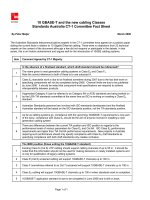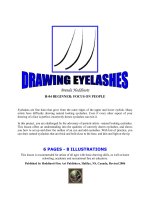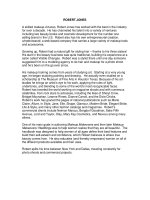Tài liệu Fact Sheet doc
Bạn đang xem bản rút gọn của tài liệu. Xem và tải ngay bản đầy đủ của tài liệu tại đây (29.4 KB, 3 trang )
______________________________________________________________________________
(303) 866-6681 or (303) 866-6605
COLORADO
Assistance for those
SERVICES TO
with both vision
CHILDREN WITH
and hearing loss
DEAFBLINDNESS
Fact Sheet
Taking Up Makeup
By Cyral Miller, Director of Outreach, TSBVI
Original article found in SEE/HEAR newsletter (vol. II, No. 1)
Editor’s Note: This article also has very pertinent information for young women who are
deafblind. As such, the term deafblindness has been added to references to visual impairment.
Social acceptance and self-esteem are often related to how young people perceive others, or think
their peers observe them. Physical appearance and types of grooming will factor enormously into
those perceptions. It is no surprise that magazines aimed at this age group heavily feature
advertisements for beauty products. In junior high or high school, many young girls are wearing
makeup to class, to social events and even for sports. Young girls with visual impairments,
including deafblindness, clearly need to be aware of this dimension of the peer scene and be
offered enough information to make informed choices on how they approach cosmetics.
Learning the proper use of makeup is an aspect of independent living skills, part of the Expanded
Core Curriculum for students who are blind or visually impaired. Many moms and older sisters
teach makeup skills to their daughters and siblings, designing adaptations as needed. In that case,
these skills will not need to be addresses at school. Other parents are not sure how to teach their
child who either cannot see at all or who has impaired vision. In those situations, it would be
appropriate to consider adding goals related to these skills to an IEP.
There are a variety of primarily informal sources for learning how to adapt the art of makeup to
accommodate blindness or visual impairment. In the Independent Living Skills Curriculum
published by the Texas School for the Blind and Visually Impaired, Volume 2, there is only this
short paragraph specifically about makeup: “Allow students to experiment with applying
different types of cosmetics. Discuss colors and shades appropriate for their skin type, hair, and
clothing. Discuss the importance of not using too much makeup. Help students choose people to
give them advice and assistance when selecting makeup (e.g., friends, sales people at cosmetics
counters).” (Independent Living Skills Curriculum, Vol.II: Self-Care and Maintenance of
Personal Environment, Loumiet, R. and Levack, N., TSBVI, Austin, TX, 1991) There are
several important related skills in the personal hygiene and grooming section of that curriculum,
such as exploring hairstyles, shaving, purchasing grooming supplies, and tweezing eyebrows.
A practical strategy is to seek out the expertise of cosmetic professionals. Many department
stores have cosmetic sections with salespeople who are skilled in selection and application of a
range of types of makeup. These individuals can give valuable tips and help to find the proper
colors and tints for specific complexions. Teachers (or family members) may want to accompany
a student with a visual impairment or who is deafblind and provide verbal explanations of what
the professional is doing.
An older written resource is The Art of Makeup for the Visually Handicapped by
Dorothy Pirozzi. This booklet was published by the Lighthouse, from The New York Association
for the Blind in the 1970’s and may no longer be available. Ms. Pirozzi, a former fashion model,
asserts “I have discovered various methods of applying my own makeup that demonstrate that
blind people can makeup as well as any sighted person.” The booklet is comparable to other
written materials available on this topic, which are primarily suggestions written by blind adults
with tips based upon their experiences.
Two other references of a similar nature are found on websites: The American Foundation for the
Blind has an article with tips for makeup that application. Look on the AFB website at
/>. Another
written source based upon personal experience is the American Printing House for the Blind’s
Fred’s Head. This is an excellent resource for a wide variety of tips and suggestions about both
typical and unusual aspects of living with blindness. Go to />bin/starfinder/18399/fred.txt or go to<www.aph.org>, click on Fred’s Head Database and search
for “How to Apply Makeup”. There is also some information on a British website, Action for
Blind People at beautysence.asp>
.
Nancy Hefner and Jeri Cleveland, teachers at the Texas School for the Blind and Visually
Impaired, also shared their suggestions. Nancy even took a free period to put on her makeup and
shared tips as she went along! The consensus from these women, and others, is that the face is
such a sensitive part of the body that is relatively easy to be able to monitor putting on makeup.
The following are tips found in many of these sources:
• First, have the student practice each new makeup technique using fingers or brush with
out makeup so that she can feel exactly where to apply the makeup.
• Put on moisturizer before applying foundations, as that helps stabilize the rest of the
makeup and it has a slightly sticky feeling that makes it easier to feel where the
foundation or other products have been spread.
• When applying foundation, use a finger rather than a brush so you can feel your progress.
The key to even application is to use fingers to feather and smooth up and out so that you
can barely feel the makeup. Blend and blend some more!
• Several women suggested mineral powders that apply with a brush without fear of lines
yet feel more like a cream.
• Use a predictable sequence; start at the same place each time so that you can keep track
of what has already been applied. It is helpful to start at the cheeks, then the chin, then
the nose and finally the forehead.
• For powder-start on one cheek and go across, being careful around the nose. Makeup
tends to pool on either side of the nose so feather carefully with your fingers.
• Blush is easy to apply once you find the cheekbones and follow that line up to the
hairline. To apply blusher, smile and brush onto the apples of your cheeks away from
your nose towards the ear. Less is better with amount.
• Count the number of strokes needed to apply each kind of product when you are learning
how to apply, so that you can put on the right amount.
• Cream-based makeup is less prone to going in the wrong places.
• Start with a clear gloss or Chap Stick until the student is comfortable with the motion,
and then proceed to deeper lipstick colors. You only have to apply lipstick to your
bottom lip. It will naturally cover the top. Pinch the sides of your mouth and the centre
of the top lip to get rid of any excess.
• Some people prefer a brush and some a sponge for applying eye shadow. With the eyes
closed, it can be applied and then smoothed with the fingers. Use the fingers to wipe
away any excess that may have accumulated under the eyes as well as in the inner and
outer corners.
• Eyeliner and mascara can be harder to apply and some consider them optional. For
special occasions, many spas offer eyebrow and eyelash tinting that lasts for about three
weeks. Some women have had eyeliner or mascara permanently applied by a beautician.
• Place the mascara brush at the lash roots and slowly pull it away as you close and open
your eye to avoid letting it touch the area around the eye.
• Keep your eyebrows tidy by brushing them through regularly with a toothbrush or
stroking through a dab of Vaseline.\
• If you want to use nail polish, consider a clear coat or simply buff them. You may also
put a little Vaseline around the finger, next to the nail so that any mistakes can be wiped
off easier. Keep your nail polish in the refrigerator so that it will be easier to feel where
the polish is going. Or, simply save your money and get a manicure and/or a pedicure.
Many, if not most, people with visual impairments or deafblindness have some level of
residual vision. A strong magnifier mirror and proper lighting can help take some of the
guesswork out of applying makeup. There are also products such as Eye-to-Eye cosmetic
lens (
) that offer magnifying powers with a single lens
designed to only cover one eye at a time. This allows application of makeup to one eye while
getting the best possible vision from the other. A visit to a cosmetics department will yield
many other designed for any user that can help make the task easier for a person with visual
impairments or deafblindness, too.
Looking good can be as important to a young girl with a visual impairment or deafblindness
as it is to her sighted peers. Not all girls will want to wear makeup, but knowing what it is,
and how to apply it for the best effect, is another way to provide a girl with opportunities for
self-expression and self-determination pm how to present herself to the world. Have fun
exploring the world of cosmetics!









